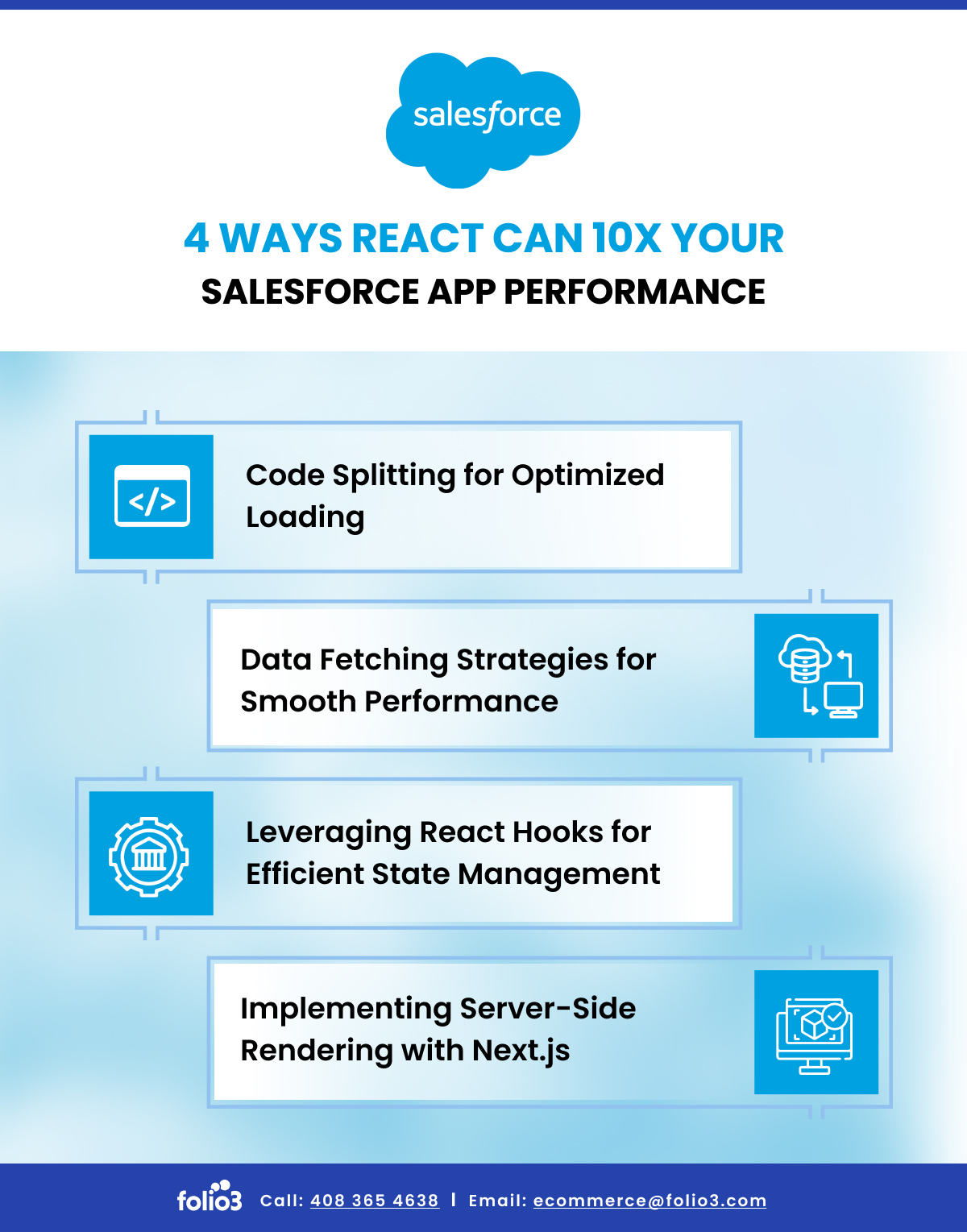First appeared in 2013, React is a JavaScript library that is now commonly used for building user interfaces. It is mainly for single-page applications where dynamic content updates are crucial. The Meta Community maintains React Salesforce app performance, allowing developers to create reusable UI elements.
The script has also introduced JSX, which facilitates the creation of dynamic and expressive UIs. Due to its widespread adoption and strong community, React has become a go-to choice for front-end development.
What Is React?
React employs a virtual DOM (Document Object Model) to enhance rendering speed. When data changes, React updates a virtual representation of the DOM and then calculates the most efficient way to update the actual DOM.
On top of that, it supports the development of complex Salesforce applications by encouraging a modular and declarative approach to building UI components, as it can be seamlessly integrated with other libraries and frameworks. In the upcoming section, you will discover the four proven ways that impact the React Salesforce app performance.
4 Ways React Can 10x Your Salesforce App Performance
React Salesforce app performance best practices can multiply the Salesforce App performance ten times. Here is how that happens:
Code Splitting for Optimized Loading
The implementation of code splitting means breaking down your Salesforce app’s code into smaller ones. It also works on manageable chunks as well.
To optimize React Salesforce app performance, this helps the application manage the load as it only necessitates the code for the current user’s interaction, thus reducing initial load times. As users navigate through the app, it enhances overall performance by minimizing the initial payload.
Leveraging React Hooks for Efficient State Management
React Salesforce app performance is facilitated by React Hooks, which provides a more streamlined way to manage the state in functional components. Remember, efficient state management is essential for maintaining a responsive and performant app.
Hence, by using this, users can avoid unnecessary Hooks. It improves the performance of the app. Simply put, the app will be able to efficiently update and render components based on state changes.
Implementing Server-Side Rendering (SSR) with Next.js
Server-side rendering involves rendering React components on the server instead of the client. By using Next.js, a React framework with built-in SSR support, you can enhance the performance of your Salesforce app.
SSR reduces users’ time waiting for pages to load by serving pre-rendered content. This results in faster initial page loads and improved search engine optimization (SEO).
Data Fetching Strategies for Smooth Performance
To sustain responsive apps, efficient data fetching holds immense importance. However, inducing appropriate fetching strategies, like optimizing API calls, caching data, and minimizing unnecessary requests, contributes to a smoother user experience.
This strategic management of data retrieval reduces latency and enhances overall performance. Eventually, it ensures that your React Salesforce app performance is top-notch and capable of handling high traffic volumes.
Advanced React Techniques for Salesforce
Mastering the fundamentals of React in Salesforce is great. However, exploring advanced React Salesforce app performance techniques is key to truly elevating your development skills. Here are some areas to delve into:
1. Custom Hooks and Render Props
Custom hooks let you share reusable state logic between React components without prop drilling. Consider building custom hooks for common functionalities like fetching data, managing authentication, or handling side effects.
Also, instead of passing data or components as props, render props provide a function that receives children and renders them based on your logic. It promotes cleaner component composition and separation of concerns within React Salesforce app performance.
2. Error Handling and Boundary Components
Go beyond basic try-catch statements with error handling. Utilize tools like React Error Boundaries to capture errors at specific components and render fallback UIs for a better user experience.
With boundary components, you can isolate errors within specific portions of your UI, preventing cascading failures and improving app stability.
3. Performance Optimization
Memoize expensive function calls or component renders to prevent unnecessary re-calculations and improve performance. Use code-splitting to break down your application into smaller code chunks for asynchronous loading. It helps reduce initial load times and improve perceived performance.
Moreover, you can use virtual DOM to optimize DOM manipulations and leverage techniques like batching updates to minimize browser repaints.
4. Testing and Debugging
Move beyond basic unit tests. Explore deeper testing strategies like integration tests, end-to-end tests, and visual regression testing for comprehensive quality assurance.
Also, familiarize yourself with advanced debugging tools provided by Salesforce implementation partner CLI and browser developer tools to effectively troubleshoot complex issues.
5. Advanced UI Techniques
Some advanced UI techniques that you can use are:
- Portals: Render UI elements outside the React hierarchy for greater flexibility and handling modal windows or overlays efficiently.
- Context API: Manage global state across components without prop drilling through context providers and consumers.
- Higher-Order Components (HOCs): Reuse common logic across components without duplicating code using HOCs for functionalities like authentication, authorization, or data fetching.
Real-World Examples of React’s Impact on Salesforce
These three real-world examples showcase React Salesforce app performance in the best possible manner.
Case Study 1: Boosting Complex Dashboard Performance
As a result of relying on intricate dashboards, a financial services company with traditional Salesforce development services suffered from sluggish loading times and cumbersome interactions.
Solution: The company implemented React to rebuild the dashboards, resulting in incredible React Salesforce app performance.
- 50% reduction in loading times: Dashboards displayed crucial information almost instantly, empowering faster analysis and response.
- Improved interactivity: Users could seamlessly filter, sort, and drill down into data, gaining deeper insights with ease.
- Enhanced visual appeal: React’s flexibility allowed for the creation of sleek and interactive dashboards, boosting user engagement.
Case Study 2: Streamlining Data-Driven Sales Processes
A rapidly growing software company was struggling to manage its complex sales pipeline effectively.
Solution: React’s declarative nature and reusable components facilitated the following:
- Automated data visualization: Through interactive dashboards, sales reps gained real-time insights into key metrics like deal stages, conversion rates, and competitor activity.
- Streamlined lead qualification: React’s forms and workflows simplified lead qualification, helping reps prioritize high-potential deals.
- Enhanced collaboration: The application fostered seamless communication between sales and marketing teams.
Case Study 3: Enhancing Mobile App Responsiveness
A healthcare organization’s mobile app was facing hampered user experience and limited app adoption among healthcare professionals.
Solution: Upon opting for a React Salesforce App performance to rebuild their mobile app, it ended up on.
- Native-like performance: The app felt smooth and responsive across different devices, providing a consistent user experience.
- Reduced development time: React Native’s code reusability facilitated faster development and updates, allowing the organization to adapt swiftly to evolving healthcare needs.
- Simplified maintenance: With a single codebase for all platforms, the organization streamlined maintenance and bug fixes, reducing operational costs.
Overcoming Challenges for React Integration With Salesforce
React Salesforce app performance comes with a set of challenges that developers must navigate to ensure a smooth and efficient workflow.
Balancing Learning Curve With Development Speed
One of the initial challenges developers face when integrating React with Salesforce is the learning curve associated with adopting a new technology. That is why balancing the need to grasp React’s concepts with the urgency to deliver projects within tight timelines is significant.
To tackle this, organizations should invest in resources and foster a collaborative environment where experienced developers can mentor those new to React. This way, they can expedite the learning process.
Integrating React Components With Existing Salesforce UI
Neglecting the existing Salesforce UI is not an option for a successful React integration. Blending both of them is essential to maintain a cohesive user experience. Challenges also arise in ensuring consistent styling, responsiveness, and functionality across the hybrid interface.
To address this in React Salesforce App performance, developers should leverage the Salesforce Lightning Design System (SLDS) to maintain a consistent look and feel.
Testing and Debugging React-Powered Salesforce Apps
Testing and debugging are integral aspects of any software development process. Integrating React with Salesforce introduces new challenges in this domain. However, tackling this issue is possible if developers implement a robust testing strategy that includes both Salesforce-specific and React-specific testing frameworks.
Apart from this, the adaptation of constant integration and continuous deployment (CI/CD) pipelines ensures that changes are thoroughly tested before reaching production environments.
Future of React in Salesforce
React Salesforce app performance promises further evolution and expansion over the years. Several key trends will reshape its trajectory. Some of them are:
1. Emerging Libraries and Frameworks for Enhanced Performance
The React Salesforce app performance ecosystem is constantly innovating, and new libraries and frameworks are emerging to address specific performance challenges.
Both libraries and frameworks play a major part in speeding up the loading times and ensuring smoother user experiences.
2. Integration With Salesforce Lightning Web Components
As Salesforce Lightning Web Components (LWC) gain wider adoption, their seamless integration with React opens up exciting possibilities.
This hybrid approach fosters efficient development and improves compatibility with the evolving Salesforce consulting services.
3. Low-Code/No-Code Options for Building React-powered Salesforce Apps
The low-code/no-code movement is democratizing app development. Moreover, Salesforce embraces this trend by offering tools like Lightning App Builder and Salesforce Flow.
Developers with minimal coding experience utilize these platforms to build simple React-based applications, extending the reach and impact of React Salesforce app performance.
Conclusion
React acts as the much-needed rocket fuel, injecting vitality into your Salesforce 360 experience.
This evidence is enough to speak for itself when measuring React Salesforce App performance. The results show how React is a staggering 10x improvement that banishes sluggish dashboards and clunky interfaces from the past.
With Salesforce Hyperforce, we can combine the flexibility of React with Salesforce’s secure and scalable cloud infrastructure. This means our React Salesforce apps will perform much better than before. We no longer need to worry about past limitations. We can look forward to a future where our apps are not just fast, but incredibly fast. The potential for excitement and new ideas is huge, offering endless possibilities.
FAQs
Is React Difficult to Learn?
React has a learning curve, but its well-organized documentation, strong community support, and component-based structure make it accessible for developers of various skill levels.
Can I Use React With My Existing Salesforce App?
Yes, React can be seamlessly integrated with your existing Salesforce app. Its modular nature allows for easy adoption and incorporation into different parts of your application.
How Much Will It Cost to Use React in My Salesforce App?
React is an open-source JavaScript library, and there is no direct cost associated with it. However, the React Salesforce app performance implementation costs may vary based on your specific project requirements.

Hasan Mustafa
Engineering Manager Salesforce at Folio3
Hasan Mustafa delivers tailored Salesforce solutions to meet clients' specific requirements, overseeing the implementation of scenarios aligned with their needs. He leads a team of Salesforce Administrators and Developers, manages pre-sales activities, and spearheads an internal academy focused on educating and mentoring newcomers in understanding the Salesforce ecosystem and guiding them on their professional journey.
